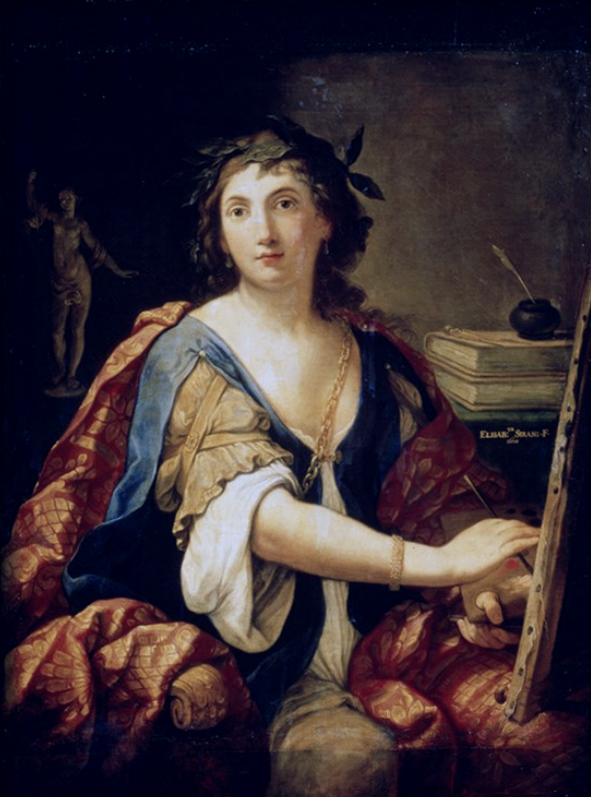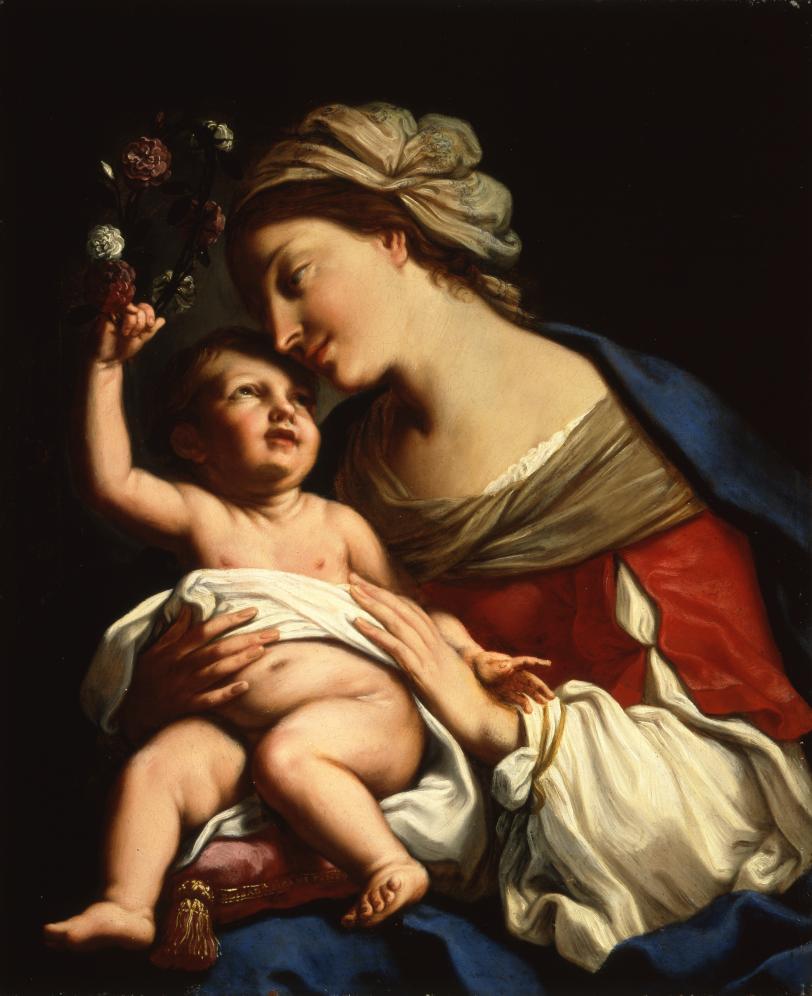Elisabetta Sirani
Active in: Italy
Biography
Born in Bologna on January 8, 1638, Elisabetta Sirani was the daughter of Giovanni Andrea Sirani (1610–1670), a painter and student of Guido Reni (1575–1642). Sirani first trained in her father’s studio and quickly became a gifted artist, recognized for her talents throughout Bologna. Her sisters Barbara Sirani (1641–1692) and Anna Maria Sirani (1645–1715) also became professional artists. Of the three, Elisabetta was the best known. By 1654, her father was too ill to work and Sirani began running the family workshop. Her studio was financially successful, and she was able to support her family with her teaching fees and commissions for portraits and devotional paintings.
Sirani was a prolific artist and over two hundred paintings by her have been identified. She kept meticulous records of her commissions. In addition to portraits, historical, mythological and Biblical narratives, and allegorical paintings, she produced at least thirteen large-scale public altarpieces. In the early 1660s, she began to focus on small-scale devotional images of the Virgin and Child and the Holy Family, which were commercially successful and popular among collectors. A skilled draughtsman, hundreds of drawings survive in a variety of media, including pen and ink, brush and wash, and black and red chalk.
Sirani died unexpectedly in August 1665 at the age of twenty-seven. Her death was considered suspicious and a maidservant, Lucia Tolomelli, was accused of poisoning her. The charges were later withdrawn, and art historians now believe she died of a ruptured peptic ulcer, perhaps from the stress of overseeing a financially successful, high-volume artist’s studio. She was given an elaborate funeral with a life-sized sculpture of the artist and interment in the Basilica of San Domenico. The sculpture and accompanying catafalque are illustrated in Carlo Cesare Malvasia’s Felsina pittrice: vite de’pittori bolognesi, first published in 1678, where she is described as a leading figure in the nascent history of Bolognese painting.
Selected Works
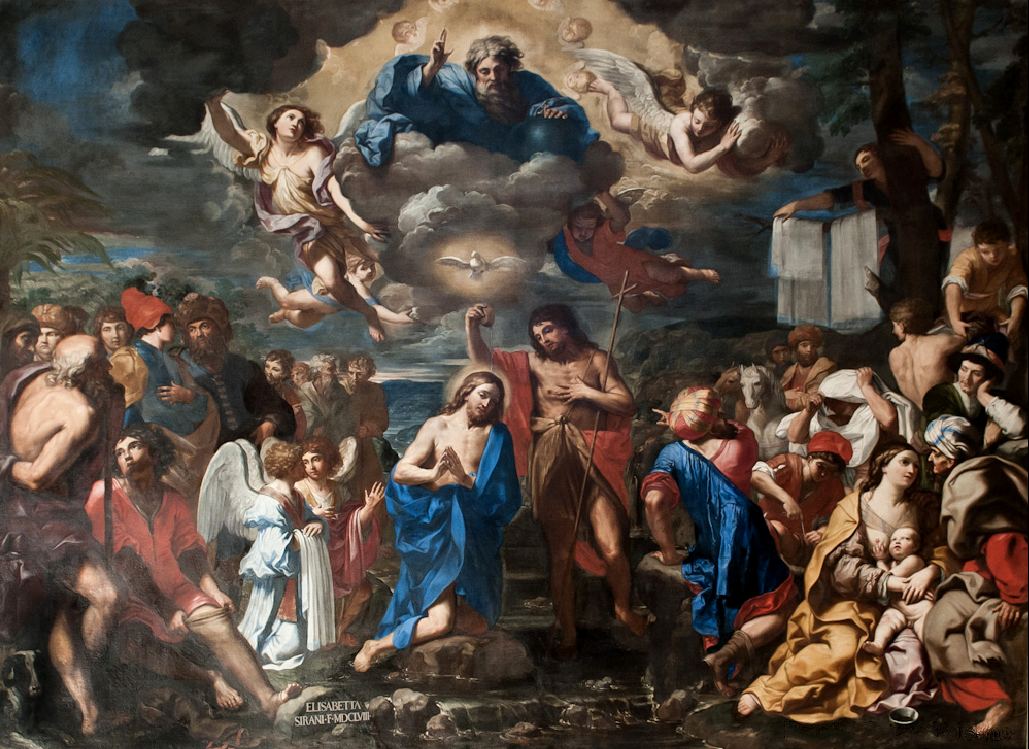
Elisabetta Sirani, Baptism of Christ, 1658. Oil on canvas, 430 x 350 cm. Chiesa di San Girolamo della Certosa, Bologna.

Elisabetta Sirani, Ecce Homo, after 1660. Oil on canvas, 107 x 83.5 cm. Muzeum umění Olomouc, Czech Republic.

Elisabetta Sirani, Finding of Moses, before 1665. Oil on canvas, 112.5 x 130 cm. Private collection.
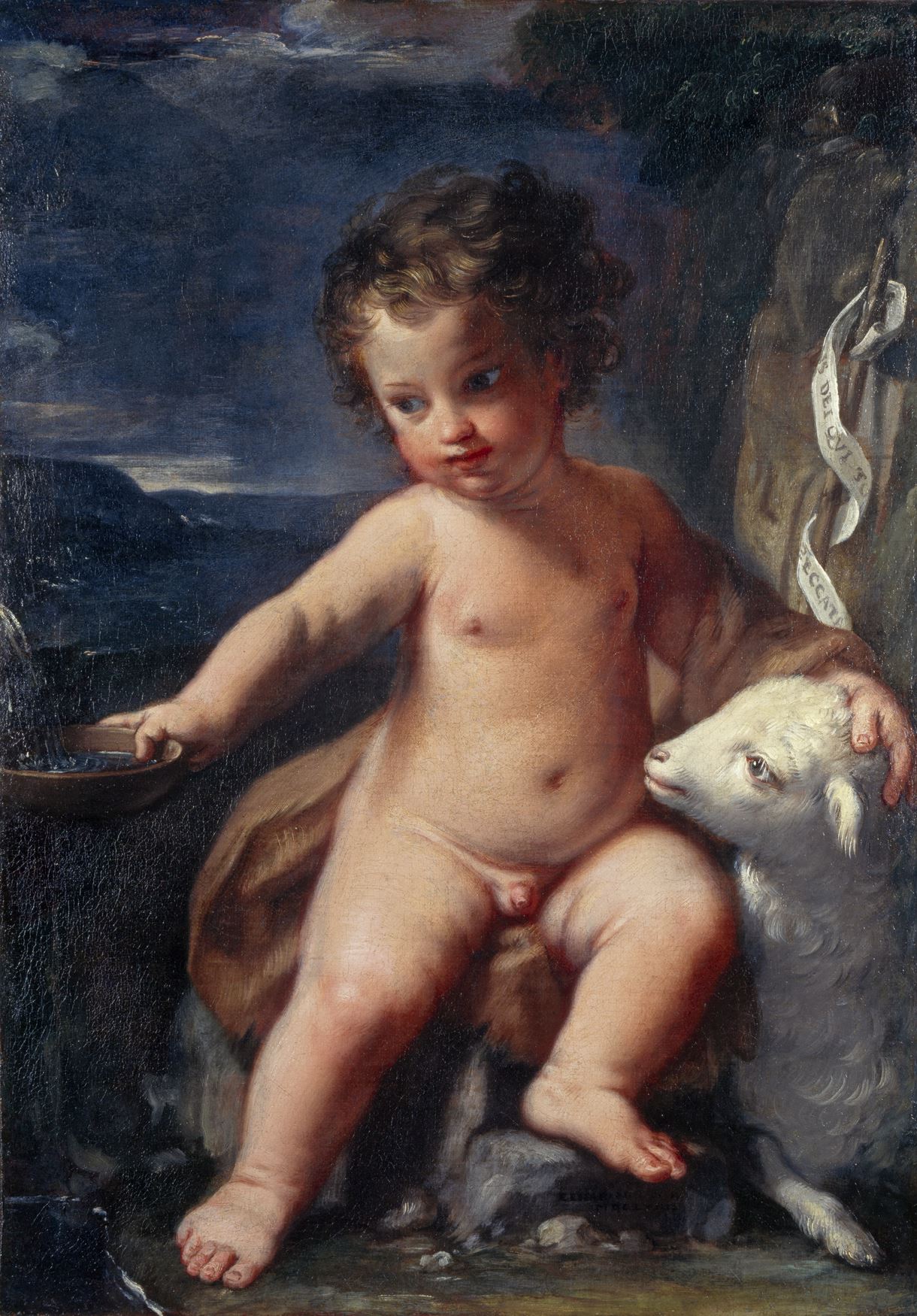
Elisabetta Sirani, The Infant Saint John the Baptist in the Wilderness, 1664. Oil on canvas, 75.5 x 62 cm. National Galleries of Scotland.

Elisabetta Sirani, Portia Wounding her Thigh, 1664. Oil on canvas, 101 x 138 cm. Collezioni d'Arte e di Storia della Fondazione della Cassa di Risparmio, Bologna.
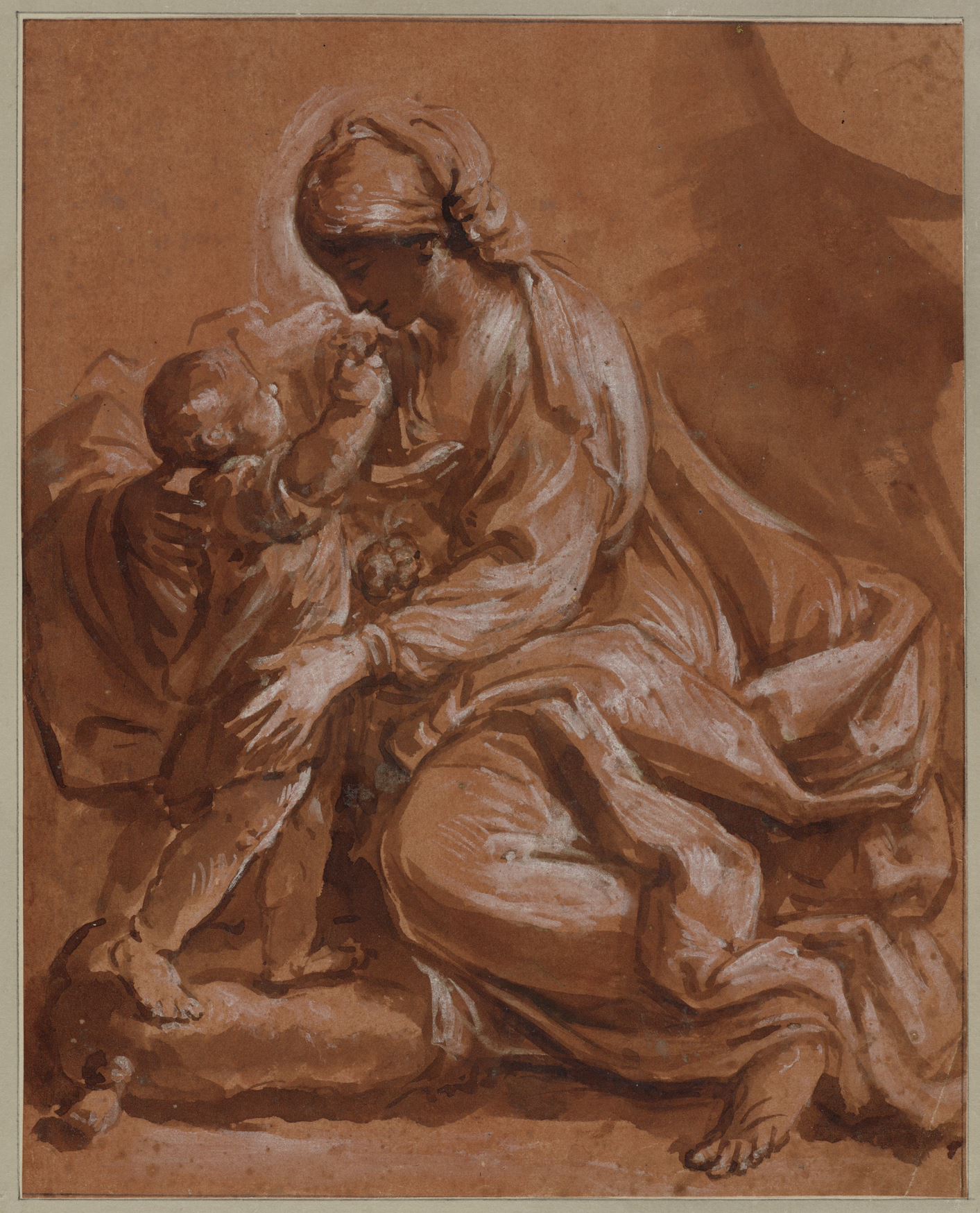
Elisabetta Sirani, Virgin and Child, ca. 1653–56. Pencil drawing with red and brown wash, 32.2 x 25.8 cm. Teylers Museum, Haarlem.
Circle
Daughter of
Giovanni Andrea Sirani (1610–1670)
Sister of
Barbara Sirani (1641–1692)
Sister of
Anna Maria Sirani (1645–1715)
Teacher of
Veronica Fontana (1651–1690)
Teacher of
Ginevra Cantofoli (1618–1672)
Teacher of
Caterina Pepoli
Teacher of
Maria Elena Panzacchi (1668–1737)
Teacher of
Lucretia Forni
Teacher of
Camelia Lanteri
Teacher of
Lucrezia Scarfaglia
Teacher of
Veronica Franchi
Bibliography
Arcangeli, Francesco, ed. Maestri della pittura del seicento emiliano. Bologna: Edizioni Alfa, 1959.
Bellini, Paolo. "Elisabetta Sirani." Nouvelles de l'estampe 30 (1976): 7-12.
Benati, Daniele. "Elisabetta Sirani." In Disegni emiliani del Sei-Settecento. Come nascono I dipinti, 178-83. Cinisello Balsamo: Amilcare Pizzi Editore, 1991.
Bentini, Jadranka, ed. Elisabetta Sirani: "pittrice eroina" 1638-1665. Bologna: Editrice Compositori, 2004.
Bohn, Babette. "The Antique Heroines of Elisabetta Sirani." Renaissance Studies 16, no. 1 (2002): 52-79.
Bohn, Babette. "Elisabetta Sirani and Drawing Practices in Early Modern Bologna." Master Drawings 42, no. 3 (2004): 207-36.
Bohn, Babette. "Elisabetta Sirani's Portrait of Signora Ortensia Leoni Cordini as St. Dorothy." Chazen Museum of Art Bulletin University of Wisconsin-Madison (2010): 6-10.
Bonafede, Carolina. Cenni Biografici e Ritratti di Insigne Donne Bolognese. Bologna: Atesa, 1845.
Borzello, Frances. Seeing Ourselves: Women's Self-Portraits. New York: Harry Abrams, 1998.
Brooke, Xanthe. Mantegna to Rubens: The Weld-Blundell Drawings Collection. London: Merrell Holbertson, 1998.
Chadwick, Whitney. Women, Art, and Society. London: Thames and Hudson, 1996.
Cheney, Liana. "Elizabetta Sirani: 'Il pennello lieto non lacrimato." In Essays on Women Artists, 71-80. Lewiston: Edwin Mellen Press, 2003.
Dabbs, Julia K. Life Stories of Women Artists, 1550-1800: An Anthology. Burlington: Ashgate, 2009.
Fine, Elsa Honig. Women & Art: A History of Women Painters and Sculptors from the Renaissance to the 20th Century. London: Allanheld & Schram, 1978.
Fortunati, Vera, Jordano Pomeroy, and Claudio Strinati, eds. Italian Women Artists from Renaissance to Baroque. Washington DC: National Museum of Women in the Arts, 2009.
Fortune, Jane, with Linda Falcone. Invisible Women: Forgotten Artists of Florence. Florence: Florentine Press, 2010.
Frisoni, F. "La vera Sirani." Paragone 29 (1978): 3-18.
Frisoni, Fiorella. "Elisabetta Sirani." In Nell'età di Correggio e dei Carracci. Pittura in Emilia nei secoli XVI e XVII, 534-37. Bologna: Nuova Alfa, 1986.
Frisoni, Fiorella. "Elisabetta Sirani." In La scuola di Guido Reni, 343-60. Modena: Artioli, 1992.
Ghirardi, Angela. "Women Artists of Bologna: The Self-Portrait and the Legend from Caterina Vigri to Anna Morandi Manzolini (1413-1774)." In Lavinia Fontana of Bologna 1552-1614, edited by Vera Fortunati, 36-41. Milan: Electa, 1998.
Graziani, Irene. In Elisabetta Sirani, "pittrice eroina," 1638-1665, edited by Jadranka Bentini and Vera Fortunati. Bologna: Compositori, 2004.
Greer, Germaine. The Obstacle Race: The Fortunes of Women Painters and Their Work. New York: Farrar, Straus, Giroux, 1979.
Harris, Anne Sutherland. "Artemisia Gentileschi and Elisabetta Sirani: Rivals or Strangers?" Women's Art Journal 31, no. 1 (2010): 3-10.
Harris, Anne Sutherland and Linda Nochlin. Women Artists, 1550-1950. Los Angeles: Los Angeles County Museum of Art, 1984.
Heller, Nancy G. Women Artists: An Illustrated History. New York and London: Abbeville, 2003.
Kurz, Otto. Bolognese Drawings at Windsor Castle. London: Phaidon, 1955.
Malvasia, Carlo Cesare. Felsina Pittrice: vite dei pittori Bolognese. Bologna: Erede di Domenico Barbieri, 1678.
Manaresi, Antonio. Elisabetta Sirani. Bologna: N. Zanichelli, 1898.
Minghetti, Marco. Le donne italiane nelle belle arti al secolo XV e XVI. Florence, 1877.
Modesti, Adelina. "Elisabetta Sirani." In Dictionary of Women Artists, edited by Delia Gaze, 1274-75. London and Chicago: Fitzroy Dearborn Publishers, 1997.
Modesti, Adelina. "The Making of a Cultural Heroine: Elisabetta Sirani 'pittrice celebrissima' di Bologna 1638-1665." In Per l'arte da Venezia all'Europa: studi in onore di Guiseppe Mario Pilo, edited by Mario Piantoni and Laura De Rossi, 399-404. Monfalcone and Gorizia: Edizioni della Laguna, 2001.
Modesti, Adelina. Elisabetta Sirani. London: Lund Humphries Ltd., 2023.
Modesti, Adelina. Elisabetta Sirani: Una virtuosa del Seicento bolognese. Bologna: Compositori, 2004.
Morselli, Raffaella. Collezioni e quadreria nella Bologna del Seicento, Inventari 1640-1707. Edited by Anna Cera Sones. Ann Arbor: Getty Research Institute, 1998.
Oretti. Pittori. MS Gozzadini 122, Archiginasio, Bologna.
Parker, Rozsika and Griselda Pollock. Old Mistresses: Women, Art and Ideology. London: Routledge & Kegan Paul, 1981.
Picinardi, G. Luigi. Il pennello lagrimato. Bologna, 1665.
Picinardi, G. Luigi. La Poesia muta celebrata della pittura loquaci applause di nobili ingegni al pennelle immortale della Signora Elisabetta Sirani pittrice bolognese. Bologna: Evangelista Dozza, 1666.
Ragg, Laura M. The Women Artists of Bologna. London: Methuen, 1907.
Rocco, Patricia. "Maniera Devota/mano Donnesca: Women, Virtue, and Visual Imagery During the Counter-Reformation in the Papal States, 1575-1675." PhD Dissertation. City University of New York, Graduate Center, 2014.
Stix, A. and A. Spitzmüller. Beschreibender Katalog der Handzeichnungen in der Staatliche Graphischen Sammlung Albertina. Vol. 6, Die Schulen von Ferrara, Bologna. Vienna, 1941.
Strasser, Nathalie. Dessins italiens de la collection Jean Bonna. Paris: École nationale supérieure des Beaux-Arts, 2006.
Toselli, Ottavio Mazzoni. Di Elisabetta Sirani pittrice Bolognese e del supposto veneficio onde credesi morta nell'anno XXVII di sua età. Bologna, 1833.
Entry Notes
For Jane Martin, the first woman to chair the art museum’s National Advisory Board, who has given her love, time, attention, and effort to her community, the university, and the museum, I gratefully dedicate this entry on Elisabetta Sirani, an especially generous and gifted artist.—Heidi Gealt
